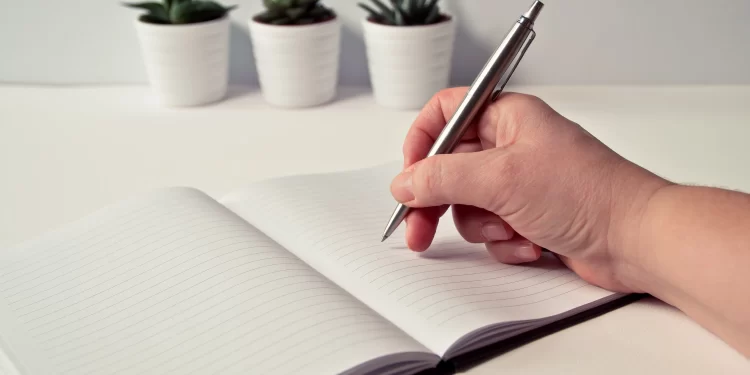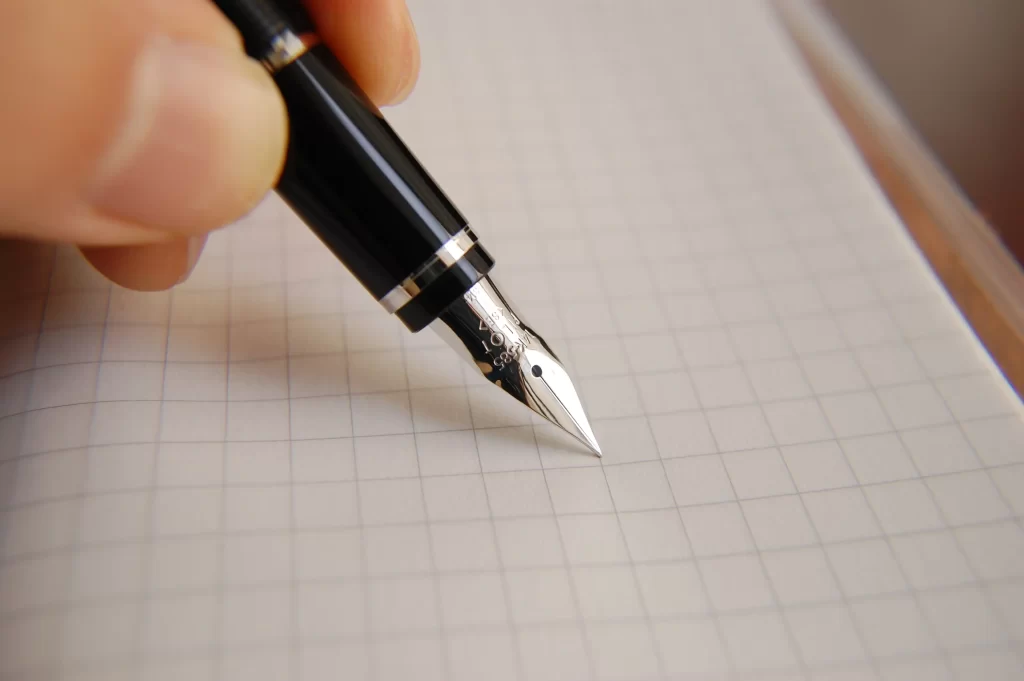Scribbles begone: How to improve your handwriting as an adult

The year is 2023. You’re at the office, or your child’s parent-teacher evening, or out with some friends, and the unthinkable happens. Someone asks you to write something with a pen and paper… you look around, panicking, for an alternative. A smartphone, a tablet, maybe even a typewriter? But you’re stuck with the task you dread the most. Showing everyone your terrible handwriting. And you know someone’s DEFINITELY going to say something.
We know how difficult it can be to have bad handwriting as an adult. Not everyone can use the “I’m a doctor” excuse. Unfortunately, as children, some individuals aren’t taught handwriting in a way that helps them learn to write smoothly and legibly – but that’s not your fault! Not everybody learns the same way!
Thankfully, as an adult, there’s still time to improve on those scribbles and turn them into a sophisticated script. We’ve put together this crash course on whipping that chicken-scratch into shape, so you can be proud to jot down notes wherever you are.

Why is having good handwriting as an adult still important?
Even in an age where we spend so much of our time producing words digitally, legible handwriting is still an integral skill to have. Good handwriting as an adult is important for several reasons:
1. Professionalism: In many professional settings, good handwriting is important to convey a sense of professionalism and attention to detail. This is especially true for jobs that require a lot of written communication, such as office administration, customer service, or legal professions. In customer service especially, there’s nothing quite like receiving a little handwritten note from someone. It adds such a heart-warming touch!
2. Communication: Clear and legible handwriting is important for effective communication. Whether you’re writing a letter, filling out a form, or taking notes, your handwriting needs to be clear and easy to read for others to understand what you’re trying to communicate. Imagine applying for a passport as a “Michelle” and receiving documentation that reads “Wucheffe” instead, and you’ll get an idea of where we’re coming from.
3. Personalisation: Handwriting is a form of personal expression, and having good handwriting can help you personalise your notes, letters, and other written materials. When your handwriting is clear and consistent, it can convey your personality and style, making your writing more engaging and memorable. On a small scale, think of signing cards. On a grander scale, think of sweeping someone off their feet with an immaculately handwritten love letter. (You can find out more about how to do that in our Love Letter blog.)
4. Cognitive Benefits: Handwriting can also have cognitive benefits, such as improving memory retention and creativity. When you write by hand, you engage your brain in a different way than when you type on a keyboard. Handwriting can help stimulate creativity, improve fine motor skills, and even reduce stress and anxiety. Remember how much making summary notes helped out when you used to write exams? That’s the same principle here!

How to improve your handwriting as an adult:
Don’t worry – you don’t have to start from scratch! Improving your handwriting entails paying specific attention to a few things, and we’ve got you covered on what those are:
1.Analyse your current handwriting
Take a look at your current handwriting and identify any problem areas. Are your letters too big or too small? Do they slant too much or not enough? Are they too close together or too far apart? Identifying these issues will help you focus on the areas that need the most improvement.
2.Practice writing
Practice is key when it comes to improving your handwriting. Set aside time each day to practice writing. Start with short sentences or copy text from books or articles. As you become more comfortable, you can start writing longer pieces. Make sure you’re writing text that actually interests you, or this will become a chore.
3.Use the right writing tools
The type of pen or pencil you use can make a big difference in your handwriting. Some people prefer a ballpoint pen, while others like a fountain pen or a pencil. Experiment with different writing tools to find one that feels comfortable and natural for you. We’ve got a guide further down in this article to help you choose the right stationery for the job!
4.Focus on the formation of the letters
Pay attention to how you form each letter. Start by practising each letter individually, making sure you’re forming it correctly. Then move on to words, making sure you’re forming each letter correctly and consistently. Finally, practice writing full sentences and paragraphs. Legibility in smaller parts contributes to the legibility of the whole and changing a habit so ingrained in you entails breaking it down into smaller parts to focus on.
4.Use handwriting worksheets
There are many handwriting worksheets available online that can help you practice your handwriting. These worksheets provide a structured way to practice specific letters or words, helping you focus on areas that need improvement. We’d suggest starting with these nifty free worksheets from The National Adult Literacy Association!
5.Practice proper hand posture and grip
Good posture and grip can help you write more smoothly and easily. Sit with your back straight and your feet flat on the floor. Hold your writing instrument of choice with a relaxed grip, using your fingers and thumb, rather than gripping tightly with your whole hand. We understand this may be quite anxiety-inducing, especially if you’ve been self-conscious about your handwriting for some time, but settle in and relax.
6.Be patient and be kind to yourself!
Improving your handwriting takes time and practice. Don’t expect to see results overnight. Instead, focus on steady progress over time. Be patient with yourself and keep practising, and you’ll see improvements gradually. Remember, just because you don’t get your lettering perfect every time, and you’re not naturally the neatest, doesn’t mean you’re not making significant improvements. The fact that you’re even choosing to upskill yourself is truly great in itself!

Choosing the right pen (or other writing tool) to improve your handwriting
Choosing the right pen – or pencil, fine liner or other implement altogether, can be an important factor in improving your handwriting as an adult. Here are some tips to help you choose the right pen for your style of handwriting:
1.Consider the pen tip
The tip of the pen can have a big impact on your handwriting. Fine-tipped pens are generally better for smaller handwriting, while broader-tipped pens are better for larger handwriting. Experiment with different tip sizes to see what works best for you. Make sure to give every new implement a few tries, though. You won’t get the hang of anything fully if you only try it out once!
2.Choose the right ink colour:
The colour of the ink can also affect your handwriting. Darker colours like black and blue can be easier to read, while lighter colours like pink and yellow may be harder to see. Choose a colour that contrasts well with the paper you’re practising on and is easy to read. Especially if you wear glasses or struggle to see up close, dark ink on white paper is your friend.
3. Find a pen that feels comfy
The feel of the pen in your hand is pretty crucial. Look for a pen that feels comfortable to hold and write with. A pen that is too heavy or too light, or that has a grip that is too slippery or too rough, can make writing more difficult. If you’re uncomfortable every time you sit down to practice handwriting improvement, you’re likely to get discouraged much sooner and give up on the whole endeavour before you’ve made any progress.
4.Look for a pen that doesn’t smudge
Smudging can be a common problem when writing, especially if you’re left-handed or unused to handwriting often. Look for a pen that dries quickly and doesn’t smudge, so your handwriting stays clean and clear. If your writing is already a little shaky, adding a degree of smudginess will not improve its legibility factor.

Overall, choosing the right pen for improving your handwriting is a personal preference. Experiment with different pen types, tips, and colours to find one that feels comfortable and enhances your handwriting.
If you find that pens just aren’t working, try starting out with pencils, markers or liners. Bettering your handwriting is your personal journey – and the rules are totally up to you! A good pen (or other writing tool) can make writing more enjoyable and help you get your handwriting looking genuinely beautiful sooner than you might think.
At PNA stores, we stock a wide variety of pens and papers to make handwriting improvement a total breeze. Stop by one of our well-stocked stores today, ask a friendly team member for help in learning more about the stationery options on offer, and take the first step to calligraphic mastery today! To find your nearest PNA, just use our nifty branch locator!


